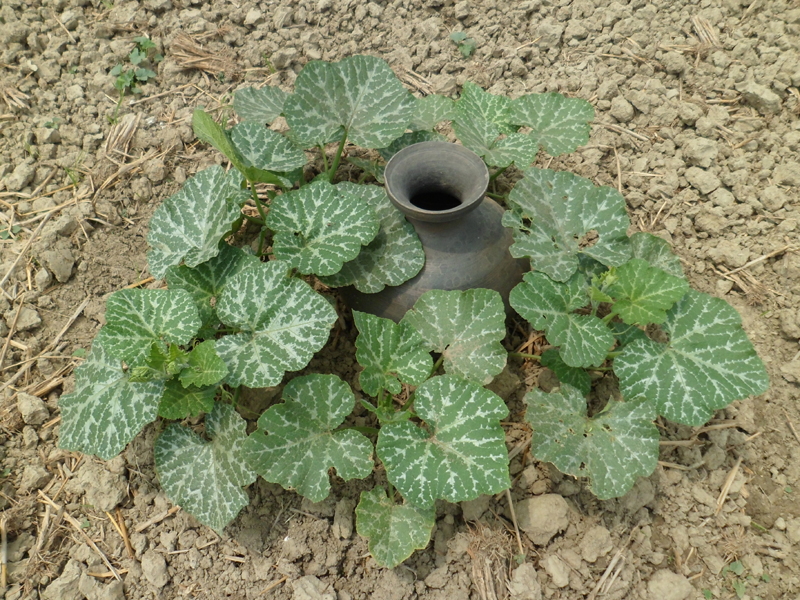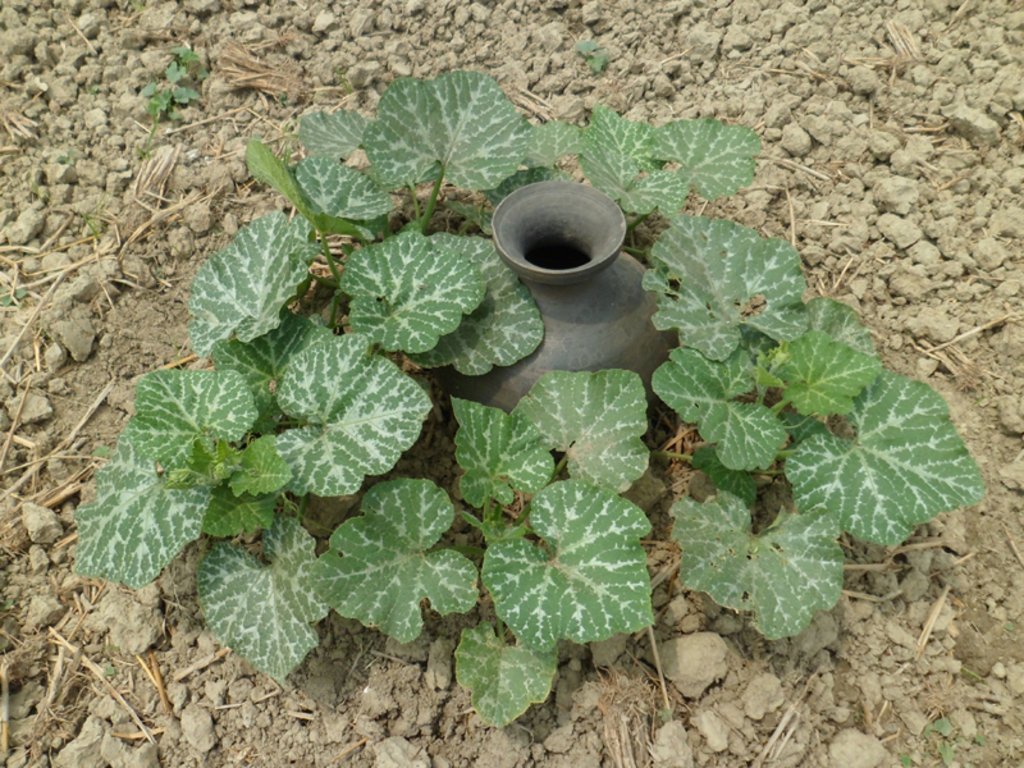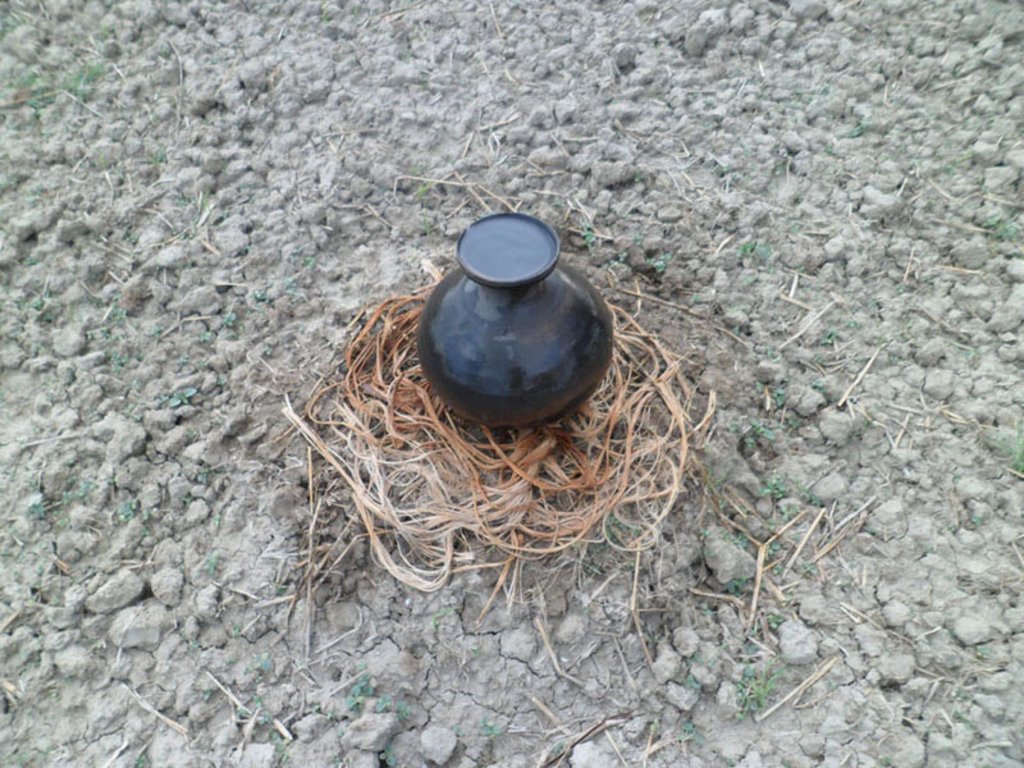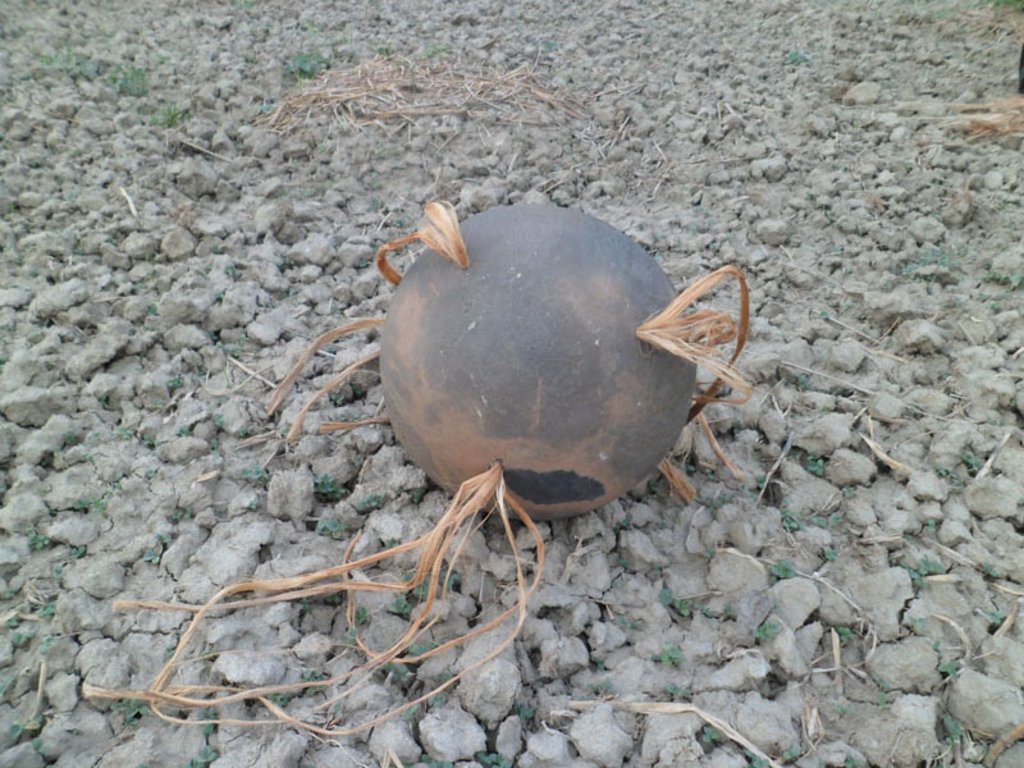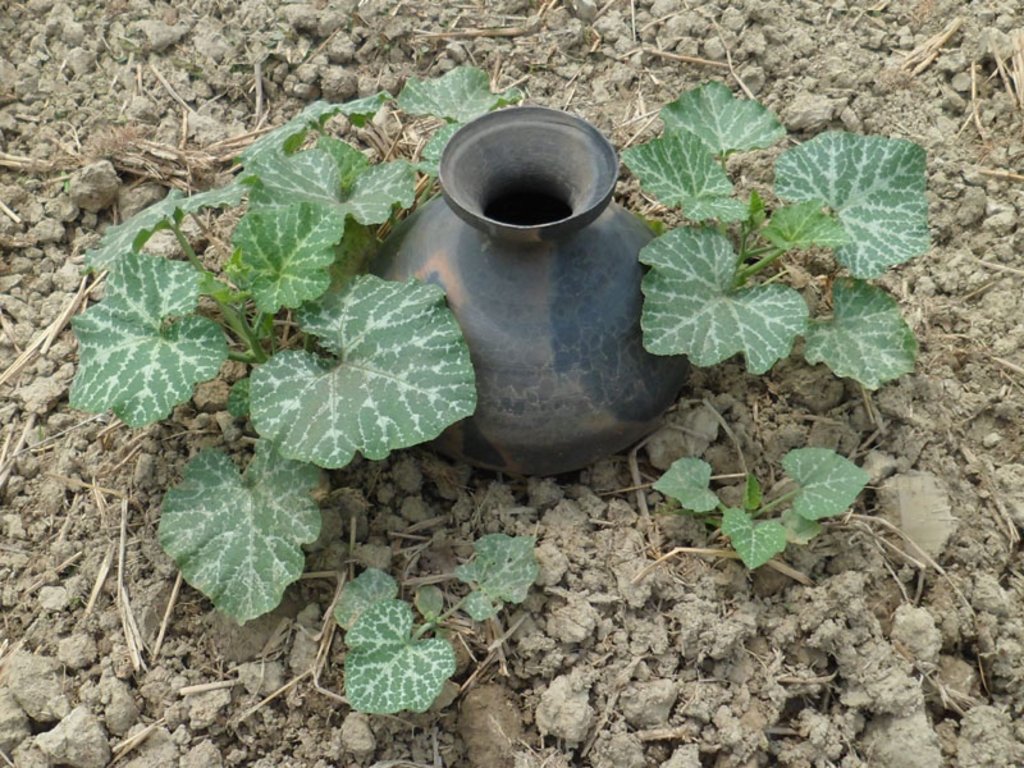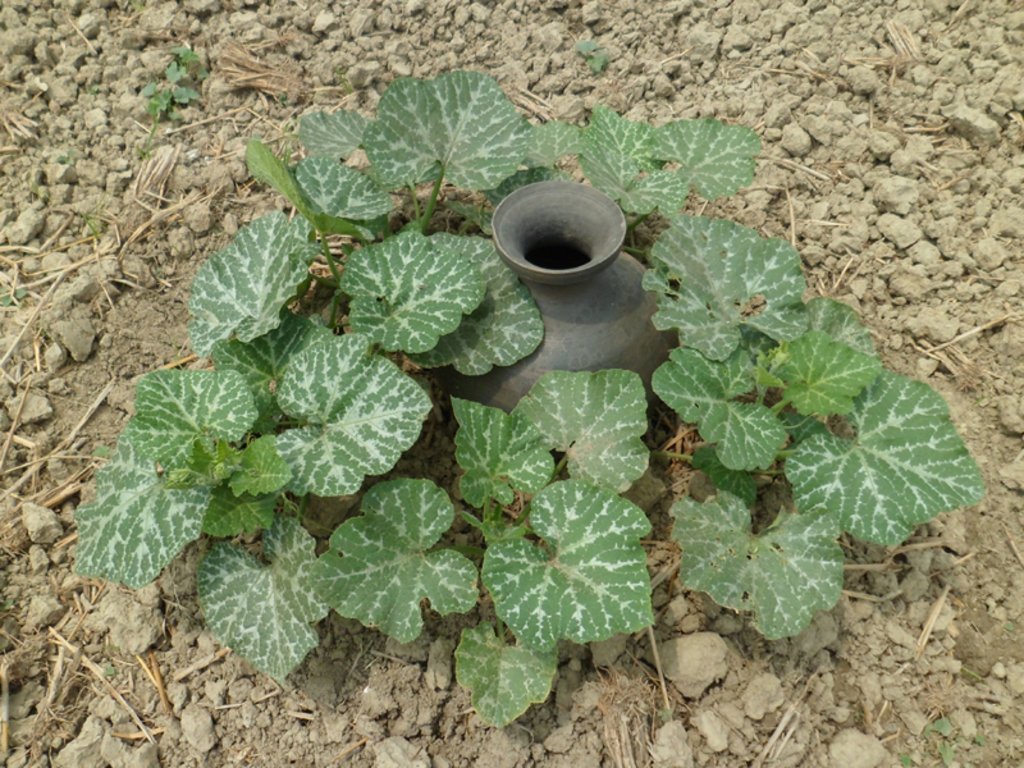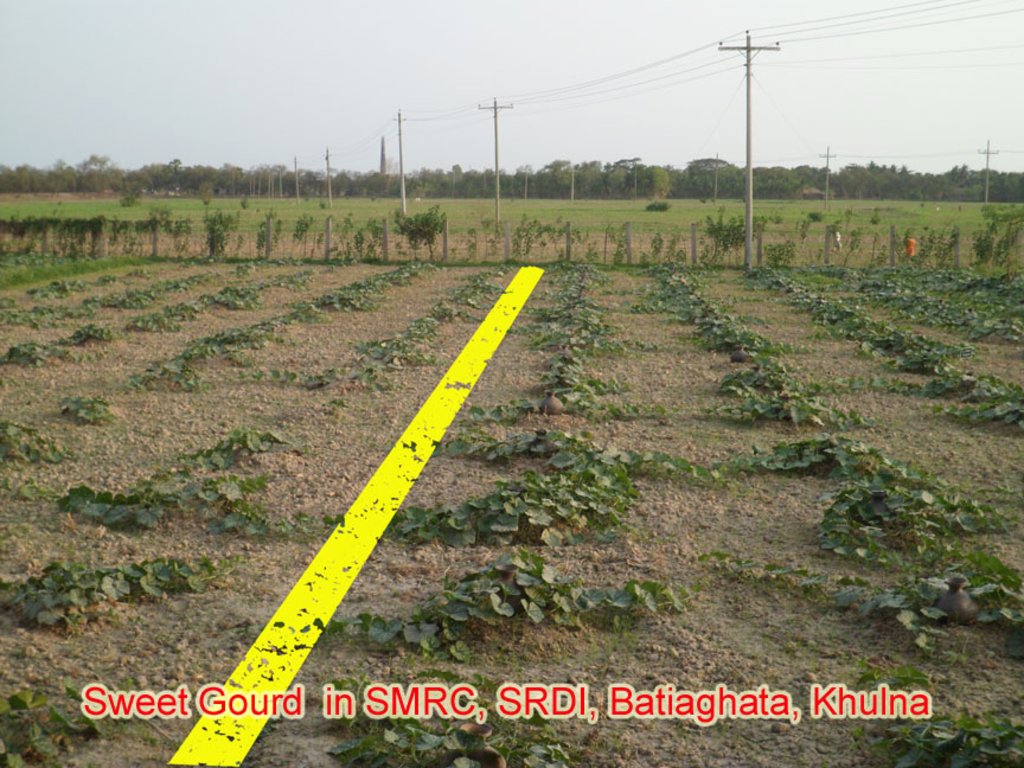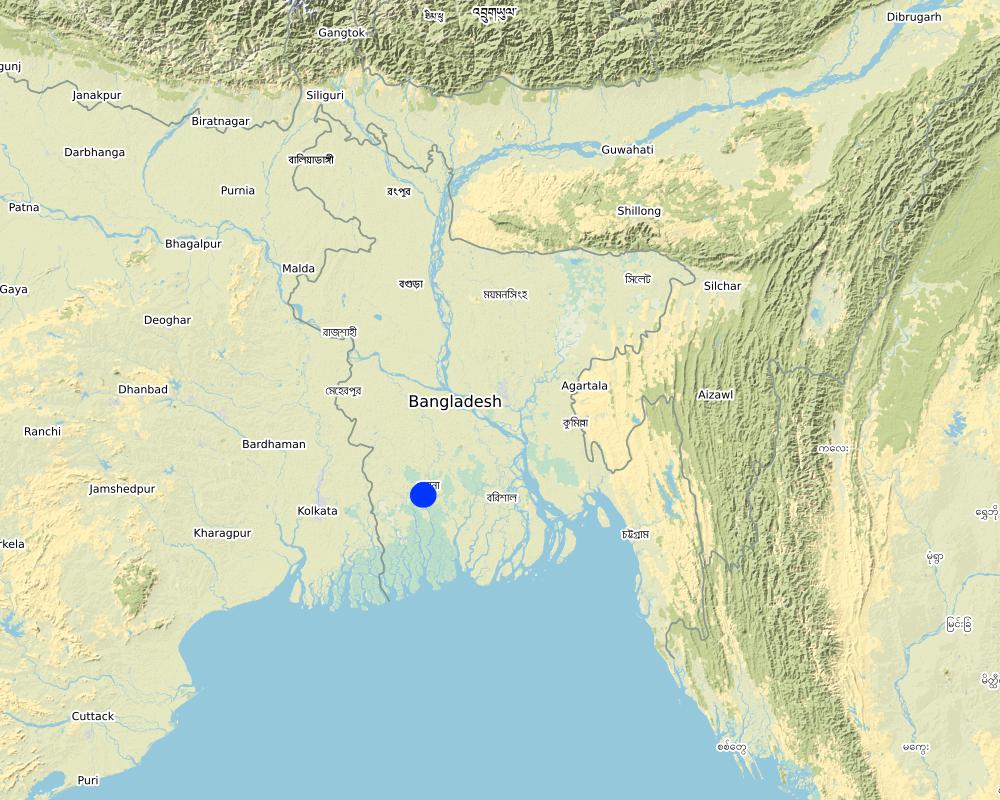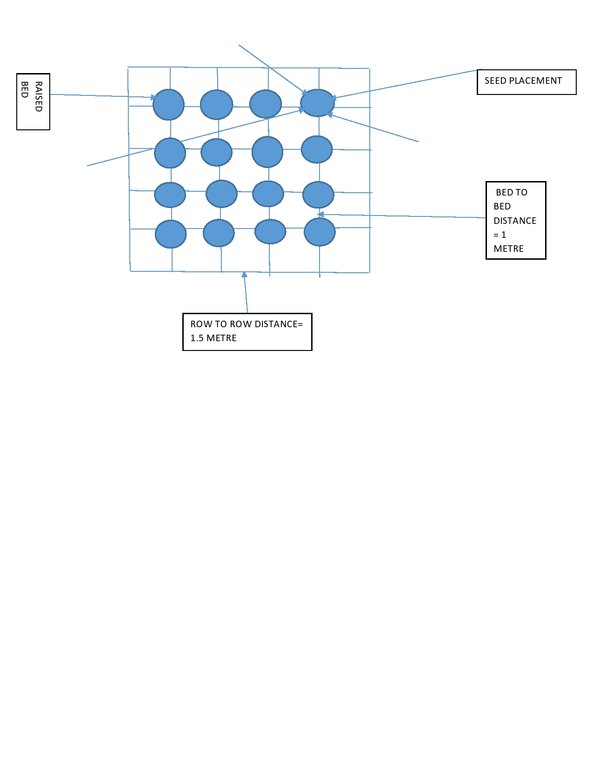Pitcher irrigation for the management of moderately saline soils [Bangladesh]
- Creation:
- Update:
- Compiler: Md Babul Hossain
- Editor: –
- Reviewer: Udo Höggel
Kalash shesh podhothi
technologies_4112 - Bangladesh
View sections
Expand all Collapse all1. General information
1.2 Contact details of resource persons and institutions involved in the assessment and documentation of the Technology
SLM specialist:
Biswas Sachindranath
+8801718691666
Soil Resource Development Institute
Principal scientific officer, Soil Resource Development Institute, Regional office, khulna
Bangladesh
SLM specialist:
Biswas Amarendra Nath
+8801718732843
Soil Resource Development Institute
Senior Scientific Officer, Soil Resource Development Institute, Regional Office, Khulna.
Bangladesh
co-compiler:
Zahid Ameer M.D.
8801552409934
zahidsrdi@yahoo.com
Soil Resource Development Institute
Soil Resource Development Institute, Head Office, Farmgate,Dhaka-1215
Bangladesh
Name of project which facilitated the documentation/ evaluation of the Technology (if relevant)
Decision Support for Mainstreaming and Scaling out Sustainable Land Management (GEF-FAO / DS-SLM)Name of the institution(s) which facilitated the documentation/ evaluation of the Technology (if relevant)
Soil Resource Development Institute (SRDI) (Soil Resource Development Institute (SRDI)) - Bangladesh1.3 Conditions regarding the use of data documented through WOCAT
When were the data compiled (in the field)?
14/2/2017
The compiler and key resource person(s) accept the conditions regarding the use of data documented through WOCAT:
Yes
1.4 Declaration on sustainability of the described Technology
Is the Technology described here problematic with regard to land degradation, so that it cannot be declared a sustainable land management technology?
No
Comments:
Pitcher irrigation technique is very effective to check the salinity development on the soil surface through capillary pores in dry season ( November to May ) in salt affected coastal area of Bangladesh.
2. Description of the SLM Technology
2.1 Short description of the Technology
Definition of the Technology:
The technology is called pitcher irrigation technology because irrigation water is provided from an earthen pitcher which has several small holes on its bottom. The earthen pitcher is placed on a raised bed which is filled with fresh irrigation water having several pores on its bottom. Then jute fibres are entered into the pores.Then, the pitchers are filled with fresh irrigation water to reduce soil salinity, increase irrigation water use efficiency, increase land cover as well as soil productivity. The technology is popular in case of vegetable cultivation in moderately salt affected area in Bangladesh.
2.2 Detailed description of the Technology
Description:
Agriculture is a major sector of Bangladesh's economy and the coastal area of Bangladesh is suitable for growing rice. More than 30% of the cultivable land in Bangladesh is in the coastal area. Out of 2.86 million hectares of coastal and off-shore lands, about 1.056 million ha of arable lands are affected by varying degrees of salinity. Farmers mostly cultivate low yielding, traditional rice varieties during wet season. Most of the land remain fallow in the dry season (January- May) because of soil salinity, lack of good quality irrigation water and late draining condition ( Karim et al., 1990; Mondal,1997 and SRDI, 2001). Crop production of the salt affected areas in the coastal regions differs considerably from non saline areas. Because of salinity, a special environmental and hydrological situation exists, that restricts the normal crop production throughout the year. In the recent past, with the changing degree of salinity of some areas due to further intrusion of saline water from the sea, normal crop production becomes very risky. Crop yields, cropping intensity, production levels and people’s quality of livelihood are much lower than that in other parts of the country, which have enjoyed the fruits of modern agriculture technologies based on high-yielding varieties, improved fertilizer and water management and improved pest and disease control measures ( BBS, 2001). At the same time food demand in the area is increasing with the steady increase in human population.
In this circumstances, Salinity Management and Research Centre( SMRC) of the Soil Resource Development Institute, located in Batiaghata, Khulna has developed some technologies which can reduce soil salinity, increase irrigation water use efficiency, increase land vegetative cover as well as soil productivity. Now the pitcher irrigation technology is popular in Khulna, Satkhira and Bagherhat districts of Bangladesh.
In this irrigation method, at first, several pores ( 2.2 mm in diameter) are made on the bottom of an earthen pitcher. Then, some jute fibres ( 30 cm long) are entered into the holes keeping 20 cm outside of the pitcher. After that, the pitcher is placed on a raised bed and fill it up with fresh water. Some seed / seedlings (Lagenaria siceraria, Solanum spp, Abelmoschus esculentus, Cucumis sativus, Benincasa hispida) are sown on different corners of the raised bed. It is done before setting the pitcher on the bed. Then water comes out / seeps very slowly through the fibres. It has several benefits as concerns the scientific point of view. First of all, it reduces irrigation water loss at least 70% as compared to flood irrigation due to reduced run off and evaporation . It supplies irrigation water continuously at the surface of the plant bed and rootzone of the crops. The pitcher needs to be refilled at 15 days interval. As a result, the salt movement is hampered / hindered to rise to the surface through capillary pores because of continuous drip irrigation. So, salinity level in the soil doesn't increase throughout the cropping season. Secondly, this technology enhances the seed germination percentage and creates a favourable environment for uptaking soil nutrient by plants and increasing the crop yield.
The farmers responded quickly to adopt the technology, because thousand hectares of land remain fallow in coastal areas in the dry season. During this period, there are two major problems: soil salinity, water salinity and scarcity of suitable irrigation water. The pitcher irrigation technology is playing an important role to reduce soil salinity as well as increasing the efficiency of irrigation and increasing crop yield.
2.3 Photos of the Technology
2.5 Country/ region/ locations where the Technology has been applied and which are covered by this assessment
Country:
Bangladesh
Region/ State/ Province:
Khulna region
Further specification of location:
The region consists of Bagerhat, Satkhira, Khulna, Jessore and Kustia districts.
Map
×2.6 Date of implementation
If precise year is not known, indicate approximate date:
- less than 10 years ago (recently)
2.7 Introduction of the Technology
Specify how the Technology was introduced:
- during experiments/ research
3. Classification of the SLM Technology
3.1 Main purpose(s) of the Technology
- improve production
- reduce, prevent, restore land degradation
- conserve ecosystem
- preserve/ improve biodiversity
- overcome soil salinity
3.2 Current land use type(s) where the Technology is applied

Cropland
- Annual cropping
Main crops (cash and food crops):
Bottle gourd, sponge gourd, okra, indian spinach, cucumber, ash gourd, sweet gourd etc.
3.3 Further information about land use
Water supply for the land on which the Technology is applied:
- mixed rainfed-irrigated
Number of growing seasons per year:
- 2
Specify:
Rainfed rice - vegetables
3.4 SLM group to which the Technology belongs
- improved ground/ vegetation cover
- irrigation management (incl. water supply, drainage)
- Mitigate soil salinity
3.5 Spread of the Technology
Specify the spread of the Technology:
- applied at specific points/ concentrated on a small area
Comments:
Pitcher irrigation technology is being used in moderately saline soil areas. In case of extreme salinity, it cannot reduce the salinity to an optimal level.
3.6 SLM measures comprising the Technology

structural measures
- S4: Level ditches, pits
Comments:
Instead of flood irrigation, controlled irrigation (pitcher irrigation) has been used in coastal areas of Bangladesh to keep moderate soil salinity in check.
3.7 Main types of land degradation addressed by the Technology

chemical soil deterioration
- Cs: salinization/ alkalinization

biological degradation
- Bc: reduction of vegetation cover
- Bh: loss of habitats
3.8 Prevention, reduction, or restoration of land degradation
Specify the goal of the Technology with regard to land degradation:
- reduce land degradation
- adapt to land degradation
4. Technical specifications, implementation activities, inputs, and costs
4.1 Technical drawing of the Technology
4.2 Technical specifications/ explanations of technical drawing
Common sized pitchers (15 litre) have to be collected. At their bottom, 5-6 holes will be made in the form of ballpoint pens (circumference at approximately 2.2 cm). Thereafter, strings of jute fibre (30 centimetre long) will be inserted into the holes. After that, the earthen pitcher will be placed in the raised soil bed (diameter 40 centimetres) in such a way that the holes and jute fibers remain in contact with the soil. Thereafter, 4 seeds should be sown on the 4 corners of the raised bed . The seeds so sown will germinate easily due to moist soil. The jute attached to the holes of the pit will allow water to infiltrate the soil so enable water supply at the root zone of the plants. The mada (raised soil bed) will always be wet. As a result, salt water from the ground level will not come up to the soil surface, thereby preventing the soil salinity in the mada (raised soil bed) area from increasing. Besides, the plants will be able to get adequate water and plant nutrients. Majaor elements of the technology are:
A large size pitcher( 15 litre water holding capacity)
5-6 pores of approx. 2.2 cm diameter are drilled into the bottom of the pitcher
Jute fibres of 30 cm length
Pitcher placed in the middle of the bed (Mada)
4 seeds are sown in the 4 corners of the bed
Salinity reduces: 2.0-2.5 dS/metre
Water requirement: 3-4 filled pitcher amount to complete a crop( Vegetable) life cycle. The irrigation water will be used only in the raised soil bed not in the whole field.
4.3 General information regarding the calculation of inputs and costs
Specify how costs and inputs were calculated:
- per Technology area
Indicate size and area unit:
1 bigha
If using a local area unit, indicate conversion factor to one hectare:
0.134 hectare
other/ national currency (specify):
Taka (tk)
Indicate exchange rate from USD to local currency (if relevant): 1 USD =:
82.0
Indicate average wage cost of hired labour per day:
500 Taka
4.4 Establishment activities
| Activity | Type of measure | Timing | |
|---|---|---|---|
| 1. | Land preparation | Agronomic | November |
| 2. | Raised bed preparation | Agronomic | November |
| 3. | Earthen pitcher collection | Management | December |
| 4. | Jute fibre collection | Other measures | December |
| 5. | Making pore on the bottom of the pitcher | Management | December |
| 6. | Filling the pitchers with irrigation water | Other measures | January |
| 7. | Placing the pitchers on the beds | Management | January |
| 8. | Seed sown on the bed | Agronomic | January |
Comments:
8 hours labour cost equals to 1 day labour
4.5 Costs and inputs needed for establishment
| Specify input | Unit | Quantity | Costs per Unit | Total costs per input | % of costs borne by land users | |
|---|---|---|---|---|---|---|
| Labour | Land preparation | persons/day | 5.0 | 500.0 | 2500.0 | 100.0 |
| Labour | Raised bed preparation | persons/day | 7.0 | 500.0 | 3500.0 | 100.0 |
| Labour | Earthen pitcher collection | persons/day | 2.0 | 500.0 | 1000.0 | 100.0 |
| Labour | Jute fibre collection | persons/day | 2.0 | 500.0 | 1000.0 | 100.0 |
| Equipment | Making pores on the bottom of the pitcher | persons/day | 5.0 | 500.0 | 2500.0 | 100.0 |
| Equipment | Filling pitcher with irrigation water | persons/day | 5.0 | 500.0 | 2500.0 | 100.0 |
| Equipment | Placing pitcher on the bed | persons/day | 5.0 | 500.0 | 2500.0 | 100.0 |
| Equipment | Seed sown on the bed | persons/day | 1.0 | 500.0 | 500.0 | 100.0 |
| Equipment | Earthen pot | number | 40.0 | 25.0 | 1000.0 | 100.0 |
| Equipment | Jute fibre | kg | 2.0 | 50.0 | 100.0 | 100.0 |
| Equipment | Drilling machine | number | 2.0 | 100.0 | 200.0 | 100.0 |
| Plant material | Seed( Bottle gourd, sweet gourd, cucumber etc) | kg | 2.0 | 200.0 | 400.0 | 100.0 |
| Fertilizers and biocides | Urea( Nitrogen) | kg | 15.0 | 16.0 | 240.0 | 100.0 |
| Fertilizers and biocides | TSP( Triple super phosphate) | kg | 6.0 | 22.0 | 132.0 | 100.0 |
| Fertilizers and biocides | MOP( Muriate of potash) | kg | 10.0 | 30.0 | 300.0 | 100.0 |
| Fertilizers and biocides | Gypsum( Sulphur) | kg | 35.0 | 3.0 | 105.0 | 100.0 |
| Other | Irrigation water cost | Tk/bigha | 3000.0 | |||
| Total costs for establishment of the Technology | 18477.0 | |||||
4.6 Maintenance/ recurrent activities
| Activity | Type of measure | Timing/ frequency | |
|---|---|---|---|
| 1. | Loosening the soil by labourer with spade | Agronomic | March |
| 2. | Putting soil on the bed by labourer with spade | Agronomic | March |
4.7 Costs and inputs needed for maintenance/ recurrent activities (per year)
| Specify input | Unit | Quantity | Costs per Unit | Total costs per input | % of costs borne by land users | |
|---|---|---|---|---|---|---|
| Labour | Loosening the soil by labourer with spade | persons/day | 5.0 | 500.0 | 2500.0 | 100.0 |
| Labour | Putting soil on the bed by labourer with spade | persons/day | 6.0 | 500.0 | 3000.0 | 100.0 |
| Total costs for maintenance of the Technology | 5500.0 | |||||
4.8 Most important factors affecting the costs
Describe the most determinate factors affecting the costs:
Labour costs affect the total technology cost. Labour scarcity is severe in coastal areas of Bangladesh.
5. Natural and human environment
5.1 Climate
Annual rainfall
- < 250 mm
- 251-500 mm
- 501-750 mm
- 751-1,000 mm
- 1,001-1,500 mm
- 1,501-2,000 mm
- 2,001-3,000 mm
- 3,001-4,000 mm
- > 4,000 mm
Specify average annual rainfall (if known), in mm:
2500.00
Specifications/ comments on rainfall:
Monsoon rainfall (June to October), in winter season very little rain (October to March).
Indicate the name of the reference meteorological station considered:
Khulna
Agro-climatic zone
- sub-humid
5.2 Topography
Slopes on average:
- flat (0-2%)
- gentle (3-5%)
- moderate (6-10%)
- rolling (11-15%)
- hilly (16-30%)
- steep (31-60%)
- very steep (>60%)
Landforms:
- plateau/plains
- ridges
- mountain slopes
- hill slopes
- footslopes
- valley floors
Altitudinal zone:
- 0-100 m a.s.l.
- 101-500 m a.s.l.
- 501-1,000 m a.s.l.
- 1,001-1,500 m a.s.l.
- 1,501-2,000 m a.s.l.
- 2,001-2,500 m a.s.l.
- 2,501-3,000 m a.s.l.
- 3,001-4,000 m a.s.l.
- > 4,000 m a.s.l.
Indicate if the Technology is specifically applied in:
- not relevant
5.3 Soils
Soil depth on average:
- very shallow (0-20 cm)
- shallow (21-50 cm)
- moderately deep (51-80 cm)
- deep (81-120 cm)
- very deep (> 120 cm)
Soil texture (topsoil):
- fine/ heavy (clay)
Soil texture (> 20 cm below surface):
- fine/ heavy (clay)
Topsoil organic matter:
- low (<1%)
5.4 Water availability and quality
Ground water table:
< 5 m
Availability of surface water:
medium
Water quality (untreated):
unusable
Is water salinity a problem?
Yes
Specify:
In dry winter season, the water as well as soil is moderately to highly saline. In the rainy season, salt washed out by heavy rain and flood water.
Is flooding of the area occurring?
Yes
Regularity:
frequently
5.5 Biodiversity
Species diversity:
- low
Habitat diversity:
- low
5.6 Characteristics of land users applying the Technology
Sedentary or nomadic:
- Sedentary
Market orientation of production system:
- subsistence (self-supply)
Off-farm income:
- less than 10% of all income
Relative level of wealth:
- poor
Individuals or groups:
- individual/ household
Level of mechanization:
- manual work
- mechanized/ motorized
Gender:
- women
- men
Age of land users:
- youth
- middle-aged
5.7 Average area of land owned or leased by land users applying the Technology
- < 0.5 ha
- 0.5-1 ha
- 1-2 ha
- 2-5 ha
- 5-15 ha
- 15-50 ha
- 50-100 ha
- 100-500 ha
- 500-1,000 ha
- 1,000-10,000 ha
- > 10,000 ha
Is this considered small-, medium- or large-scale (referring to local context)?
- small-scale
5.8 Land ownership, land use rights, and water use rights
Land ownership:
- individual, not titled
- individual, titled
Land use rights:
- individual
Water use rights:
- open access (unorganized)
5.9 Access to services and infrastructure
health:
- poor
- moderate
- good
education:
- poor
- moderate
- good
technical assistance:
- poor
- moderate
- good
employment (e.g. off-farm):
- poor
- moderate
- good
markets:
- poor
- moderate
- good
energy:
- poor
- moderate
- good
roads and transport:
- poor
- moderate
- good
drinking water and sanitation:
- poor
- moderate
- good
financial services:
- poor
- moderate
- good
6. Impacts and concluding statements
6.1 On-site impacts the Technology has shown
Socio-economic impacts
Production
crop production
Comments/ specify:
.
crop quality
risk of production failure
production area
Comments/ specify:
As the technology has been proved promising for salt affected soil management, its usage has spreaded for crop production in large area.
land management
Income and costs
expenses on agricultural inputs
farm income
Comments/ specify:
Agricultural inputs decreased
diversity of income sources
Comments/ specify:
Production of different vegetables increased. So, the produces are being used in agro based industries for different purposes.
economic disparities
Comments/ specify:
Different classes of people are now being involved in vegetable production in saline areas and the poor and unemployed people are earning money by selling agricultural products.
workload
Comments/ specify:
As the technology requires so many people for pitcher setting on the bed, so workload will be increased.
Socio-cultural impacts
food security/ self-sufficiency
health situation
land use/ water rights
SLM/ land degradation knowledge
Ecological impacts
Water cycle/ runoff
water quantity
surface runoff
excess water drainage
groundwater table/ aquifer
evaporation
Comments/ specify:
Evaporation decreases due to drip irrigation comparison to flood irrigation.
Soil
soil moisture
soil cover
soil loss
soil accumulation
soil crusting/ sealing
Comments/ specify:
Due to loosening of raised soil beds.
soil compaction
nutrient cycling/ recharge
salinity
soil organic matter/ below ground C
acidity
Comments/ specify:
As the soil will be kept moist during crop production, soil acidity will be reduced.
Biodiversity: vegetation, animals
Vegetation cover
biomass/ above ground C
plant diversity
animal diversity
beneficial species
habitat diversity
pest/ disease control
Climate and disaster risk reduction
drought impacts
emission of carbon and greenhouse gases
micro-climate
6.2 Off-site impacts the Technology has shown
water availability
groundwater/ river pollution
impact of greenhouse gases
Comments/ specify:
Cropping intensity has increased due to the technology adoption and the crops are absorbing more CO2.
6.3 Exposure and sensitivity of the Technology to gradual climate change and climate-related extremes/ disasters (as perceived by land users)
Gradual climate change
Gradual climate change
| Season | Type of climatic change/ extreme | How does the Technology cope with it? | |
|---|---|---|---|
| annual temperature | increase | moderately | |
| seasonal temperature | summer | increase | moderately |
| annual rainfall | decrease | well | |
| seasonal rainfall | dry season | decrease | very well |
Climate-related extremes (disasters)
Meteorological disasters
| How does the Technology cope with it? | |
|---|---|
| tropical storm | well |
| local thunderstorm | not known |
Climatological disasters
| How does the Technology cope with it? | |
|---|---|
| drought | well |
Hydrological disasters
| How does the Technology cope with it? | |
|---|---|
| general (river) flood | well |
| storm surge/ coastal flood | moderately |
Biological disasters
| How does the Technology cope with it? | |
|---|---|
| insect/ worm infestation | well |
Comments:
As the beds under the technology is a little bit raised from the level ground and the agronomic practices are more intensive than the traditional cultivation system, so insect/pest infestation is below economic injury level.
6.4 Cost-benefit analysis
How do the benefits compare with the establishment costs (from land users’ perspective)?
Short-term returns:
positive
Long-term returns:
positive
How do the benefits compare with the maintenance/ recurrent costs (from land users' perspective)?
Short-term returns:
positive
Long-term returns:
very positive
6.5 Adoption of the Technology
- 10-50%
Of all those who have adopted the Technology, how many have did so spontaneously, i.e. without receiving any material incentives/ payments?
- 50-90%
6.6 Adaptation
Has the Technology been modified recently to adapt to changing conditions?
No
6.7 Strengths/ advantages/ opportunities of the Technology
| Strengths/ advantages/ opportunities in the land user’s view |
|---|
| Increase crop production. Due to soil salinity the crop yield was very poor before adopting the technology. |
| Reduces soil salinity. The water enters into the soil through jute fibre , as a result, salt cannot come into soil surface through capillary movement. |
| Decrease cost of production. The whole field is not irrigated, instead the raised soil bed is irrigated with pitcher water. So, labour cost reduces. |
| Less irrigation water use. Water of 3-4 pitcher can complete a vegetable's life cycle. |
| Strengths/ advantages/ opportunities in the compiler’s or other key resource person’s view |
|---|
| Increase land cover in degraded land. Reducing salinity helps to grow crops vigorously throughout the field. |
| Increase soil productivity. Through decrease of soil salinity, most of the soil nutrients become available for plants. |
| Decrease soil pollution. |
| Have opportunity to extend in moderately saline areas. |
6.8 Weaknesses/ disadvantages/ risks of the Technology and ways of overcoming them
| Weaknesses/ disadvantages/ risks in the land user’s view | How can they be overcome? |
|---|---|
| Not suitable for large scale crop production. | Mechanization can be introduced instead of manual labour to cover large area. |
| Establishment cost is higher. | With proper agronomic practices, farmers are trying to get higher yield and they are producing high value crops like rock melon. |
| In case of high salinity, yield is not sufficient. | Adoption of the technology for long period of time, will help to decrease high salinity. |
| Weaknesses/ disadvantages/ risks in the compiler’s or other key resource person’s view | How can they be overcome? |
|---|---|
| Labour scarcity. | Farm mechanization is badly in need. |
| Establishment cost higher. | Financial assistance should be given from the Government. |
7. References and links
7.1 Methods/ sources of information
- field visits, field surveys
25
- interviews with land users
20
- interviews with SLM specialists/ experts
10
- compilation from reports and other existing documentation
3
7.2 References to available publications
Title, author, year, ISBN:
Saline soils of Bangladesh, 2010
Available from where? Costs?
Soil Resource Development Institute, www.srdi.gov.bd. Free of cost
7.3 Links to relevant information which is available online
Title/ description:
Causes of Salinity Intrusion in Coastal Belt of Bangladesh
URL:
http://journal.sapub.org/plant
Title/ description:
SALINITY CHANGES IN SOUTH WEST BANGLADESH AND ITS IMPACT ON RURAL LIVELIHOODS
URL:
https://www.researchgate.net/.../264419412_Salinity_Pr... -
Title/ description:
Environment and Livelihoods in Tropical Coastal Zones: Managing Agriculture .
URL:
https://books.google.com.bd/books?isbn=1845931076
Links and modules
Expand all Collapse allLinks
No links
Modules
No modules


